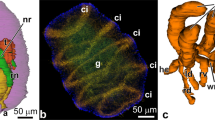Summary
The post-induction pattern of nephron organization was analysed by microdissection of 6- and 8-day chick embryo mesonephroi marked in two transversal planes by a standard technique allowing the exact determination of homologous portions. It was proved possible to distinguish four nephron populations with Malpighian corpuscles situated on the surface of the kidney, which were arranged in a ventrodorsal sequence according to age. These populations formed practically two thirds of the mesonephros. A fifth (the youngest and very heterogenous) population was localized deep in the mesonephros forming most of the dorsal half of the organ. The correct determination of the sequence of the nephron populations according to their origin was verified by the corresponding gradient of the lengths of their tubules. The oldest population (V1) constituting a ventral surface of mesonephros was the largest; it comprized in average 29±1 nephrons and stretched from the cranial to the caudal pole. The cranial narrower part of the mesonephros (crp) was composed exclusively of the V1 nephrons. The other nephron populations occurred only in the caudal, growing part of the mesonephros. The total number of nephrons per mesonephros was close to one hundred (97±7). In all isolated nephrons, the glomerulus was found to be firmly connected to the intermediate segment of the tubule at the site of the second main flexure. Developmental irregularities, as rudimentary or hypertrophic nephrons occured in crp only, but the abnormality known as “two-headed nephron” was distributed more or less at random in the mesonephros with the mean frequency 6.5% of the isolated nephrons.
Similar content being viewed by others
References
Abdel-Malek ET (1950) Early development of the urinogenital system in the chick. J Morphol 86:599–626
Bremer JL (1916) The interrelations of the mesonephros, kidney and placenta in different classes of animals. Am J Anat 19:179–210
Cambar R, Arnauld E (1970) Les modalités d'accroissement du mésonéphros chez la larve de Grenouwille agile (Rana dalmatina). CR Acad Sci Paris Ser D 270:1705–1707
Etheridge AL (1968) Determination of the mesonephric kidney. J Exp Zool 169:357–369
Friebová Z (1975a) Formation of the chick mesonephros. 1. General outline of development. Folia Morphol 23:19–28
Friebová Z (1975b) The problems of sampling homologous groups of nephrons during development of the chick mesonephros. Physiol Bohemoslov 24:1–8
Friebová-Zemanová Z (1981) Formation of the chick mesonephros. 4. Course and architecture of the developing nephrons. Anat Embryol 161:341–354
Friebová Z, Goncharevskaya OA (1975) Development of the mesonephros nephrons of chick embryo. (Russian). Arkh Anat Gistol Embriol 68:82–86
Hamburger V, Hamilton HL (1951) A series of normal stages in the development of the chick embryo. J Morphol 88:49–92
Lillie FR (1908) In: Hamilton HL (1952) Lillie's development of the chick. Holt and Co. New York, pp 465–504
Martin C (1976) Etude chez les oiseaux de l'influence du mésenchyme néphrogène sur le canal de Wolff à l'aide d'associations hétérospécifiques. J Embryol Exp Morphol 35:485–498
Möllendorf W von (1930) Übersicht über den Aufbau funktionierender Harnsysteme der Wirbelitiere. In: Handbuch der mikroskopischen Anatomie des Menschen. 7. Band, 1. Teil, J Springer, Berlin
Schreiner KE (1902) Über die Entwicklung der Amniotenniere. Zeitschr wiss Zool 71:1–188
Sedgwick A (1880) Development of the kidney in its relation to the Wollfian body in the chick. Quart J Microscop Sci 20:146–166
Sedgwick A (1881) On the early development of the anterior part of the Wollfian duct and body in the chick, together with some remarks on the excretory system of the vertebrata. Quart J Microscop Sci 21:432–468
Seichert V (1965) Study of the tissue and organ anglage shifts by the method of plastic linear marking. Folia Morphol 13:228–238
Stampfli HR (1950) Histologische Studien am Wolffschen Körper (Mesonephros) der Vögel und über seinen Umbau zu Nebenhoden und Nebenovar. Rev Suiss Zool 57:237–315
Tiedemann K (1976) The mesonephros of cat and sheep. Adv Anat Embryol Cell Biol 52:1–119
Wischnitzer S (1975) Atlas and laboratory guide for vertebrate embryology. McGraw-Hill Book Company N.Y.
Author information
Authors and Affiliations
Rights and permissions
About this article
Cite this article
Friebová-Zemanová, Z., Goncharevskaya, O.A. Formation of the chick mesonephros. Anat Embryol 165, 125–139 (1982). https://doi.org/10.1007/BF00304588
Accepted:
Issue Date:
DOI: https://doi.org/10.1007/BF00304588




